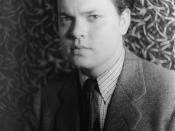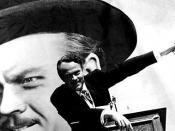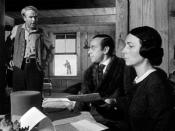When people suggest that "Citizen Kane" might be the greatest movie ever made, they aren't just talking about how Orson Welles executed every cinematic, dramatic, and literary element with great artistry. If it was just that than while it would still be a superb stylistic achievement, it would not be enduring art. What makes "Citizen Kane" such a great work of art, is Welles' dedication to detail to insure that every frame, every noise, and every look in the film supports the theme. In addition, that that is not just a theatrical motivation but attempts to show the fundamental truth of the human experience.
"Citizen Kane" is one of the richest audiovisual experiences in the history of the cinema. The expressive sound track, including music by master Bernard Herrmann, not only accompanied the film, it helped guide the storyline. The cinematography by Gregg Toland was literally groundbreaking, as seen when in order to shoot an extreme low-angle shot of Welles and Joseph Cotten, they had to make a hole in the floor.
His dramatic black-and-white lighting and deep-focus photography revitalized American film narrative, telling the story not only via plot and dialogue, but composition, camera angle, and a heady mix of visual styles. Even the style of its storytelling, especially of narrative structure rooted in flashbacks, has been pervasive.
While many viewers fall into a trap when they watch "Citizen Kane", thinking that Rosebud is the key to unlocking the theme of the film, not realizing that almost every scene possesses the clues necessary for understanding it. In fact, writer/director and principal actor Orson Welles' communication of that theme through his technique gives "Citizen Kane" its originality and staying power. Welles, who was only in his mid-twenties at the time, weaved together powerful performances, impressive lighting and camerawork,



Great understanding
Your thorough analysis of this great movie is proved through depth of observation of mise-en-scene, design and cinematics. Good job!
0 out of 0 people found this comment useful.